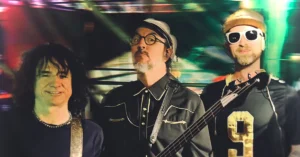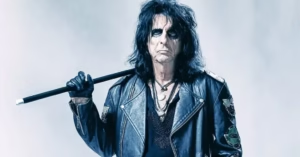Alice in Chains: The Grunge Band with a Metal Heart
Alice in Chains. I. Origins and Formation
Alice in Chains was formed in Seattle, Washington, in 1987 by:
- Jerry Cantrell – Lead guitar, vocals, songwriting
- Layne Staley – Lead vocals
- Sean Kinney – Drums
- Mike Starr – Bass (replaced in 1993 by Mike Inez)
Initially, Cantrell and Staley were in different bands. After connecting musically and personally, they formed the foundation of Alice in Chains — named after a joke glam project Layne had called “Alice N’ Chains.”
Unlike their Seattle peers, Alice in Chains had strong metal influences, with a sound rooted in Sabbath-like heaviness and a flair for vocal harmonies and acoustic introspection.
II. Early Breakthrough: Facelift (1990)
Alice in Chains debuted with Facelift, a dark, riff-heavy album that anticipated the coming wave of grunge but was still anchored in metal sensibility.
Key tracks:
- “Man in the Box” – A breakthrough single, featuring talk box vocals and lyrics about censorship
- “Sea of Sorrow,” “Bleed the Freak,” “We Die Young”
With Layne Staley’s plaintive, powerful voice and Cantrell’s doom-laden guitar, the band stood out immediately. Facelift went double platinum, and they became the first grunge band to break MTV and mainstream radio.
III. Darker Depths: Sap EP (1992) and Dirt (1992)
✦ Sap
A surprise acoustic EP showing their mellow, emotional side.
- Features Ann Wilson (Heart), Chris Cornell, and Mark Arm (Mudhoney)
- Songs like “Brother” and “Got Me Wrong” are fan favorites
- Helped define “unplugged grunge”
✦ Dirt
Released the same year, Dirt is considered their masterpiece.
Key themes: addiction, war, depression, isolation
Essential tracks:
- “Would?” – Written for Andrew Wood (Mother Love Bone); used in the Singles soundtrack
- “Rooster” – Cantrell’s tribute to his Vietnam-vet father
- “Down in a Hole” – Devastatingly introspective
- “Them Bones,” “Angry Chair,” “Junkhead”
Dirt’s raw emotion and sonic power earned it multi-platinum status and a place as one of the definitive albums of the 1990s.
IV. Struggles and Hiatus (1993–1996)
✦ Jar of Flies (1994)
- The first EP in history to debut at #1 on the Billboard 200
- Entirely acoustic, but no less haunting
- “No Excuses,” “Nutshell,” “I Stay Away” — emotionally rich and minimalistic
Jar of Flies confirmed that Alice in Chains could shed their distortion and still move mountains with just melody and mood.
However, during this period, Layne Staley’s heroin addiction worsened, and live performances became rare.
✦ Alice in Chains (1995)
- Often called “Tripod” (for the three-legged dog on the cover)
- Murkier, slower, and drug-addled
- “Grind,” “Heaven Beside You,” “Over Now”
- Layne was mostly absent from promotion and touring
Despite success, the band entered an extended hiatus due to Layne’s health.
Alice in Chains. V. The Death of Layne Staley and Aftermath (2002)
On April 5, 2002 — exactly 8 years after Kurt Cobain — Layne Staley was found dead in his apartment from a heroin and cocaine overdose. He had been reclusive and deeply isolated for years.
The music world mourned. Alice in Chains seemed over.
Yet the band members maintained that the music and brotherhood endured.
Alice in Chains. VI. Reunion and Revival with William DuVall (2006–Present)
In 2006, Jerry Cantrell, Sean Kinney, and Mike Inez reformed the band with William DuVall (ex-Comes with the Fall) sharing vocal duties with Cantrell.
DuVall never replaced Layne — instead, he became part of a new phase, helping the band move forward respectfully.
✦ Black Gives Way to Blue (2009)
- First new album in 14 years
- Features Elton John on the title track (a tribute to Layne)
- “Check My Brain,” “Your Decision,” “A Looking in View”
It was both a commercial and critical success, proving AIC could evolve without forgetting their past.
✦ The Devil Put Dinosaurs Here (2013)
- More political and philosophical
- “Stone,” “Voices,” “Hollow”
- Maintained their sludge-meets-harmony dynamic
✦ Rainier Fog (2018)
- Named after Mount Rainier; a tribute to their Seattle roots
- “Never Fade” (inspired by Layne and Chris Cornell)
- Blends grunge nostalgia with modern weight
The band continues to tour and record successfully, honoring Layne’s legacy while forging new creative ground.
Alice in Chains. VII. Musical Style and Themes
Alice in Chains blends:
- Heavy metal riffing
- Grunge rawness
- Acoustic minimalism
- Two-part vocal harmonies (Staley/Cantrell and now DuVall/Cantrell)
Recurring themes:
- Addiction and self-destruction
- Death, trauma, mental illness
- War and generational trauma
- Alienation, identity, and inner battles
VIII. Legacy and Influence
Alice in Chains stands apart for:
- Marrying grunge’s soul with metal’s weight
- Embracing both unplugged beauty and distorted chaos
- Maintaining relevance across three decades
Influenced:
- Tool, Deftones, Godsmack, Breaking Benjamin
- Mastodon, Chevelle, Stone Sour, Baroness
- Countless grunge-metal hybrids and alternative bands
Accolades:
- Over 30 million albums sold worldwide
- Multiple Grammy nominations
- Inducted into the Museum of Pop Culture’s Founders Award (2020)
- Regularly ranked among the best rock bands of the 1990s
IX. Interesting Facts
- “Nutshell” became a fan memorial anthem after Layne’s death
- Their MTV Unplugged (1996) performance is hailed as one of the genre’s finest
- Mike Inez played bass for Ozzy Osbourne before joining AIC
- Jerry Cantrell released respected solo albums (Boggy Depot, Degradation Trip)
- AIC was the first of the big four Seattle bands to achieve commercial success





